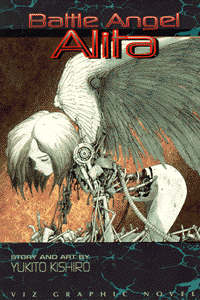
PATHWAYS
Battle Angel Alita Moves Into Her Own
by Fred Burke
The Scrapyard. Home to the rubbish and refuse -- both human and non -- of Tiphares, a utopia above the clouds. This is the world of Yukito Kishiro, and the deeper into it I delve, the more amazed I become. For in the Scrapyard, what is left of humanity must find its own way, free of the society which floats like a promise overhead. In a wasteland where meaninglessness and mortality are the givens, Kishiro weaves the most basic of humanity's philosophical dilemmas into a bloody tapestry of choices made and alliances forged.Battle Angel Alita delivers all the elements that today's comics fan demands, combining the powerful exuberance of Todd McFarlane's Spawn, the lusty innocence of Adam Warren's Dirty Pair, and the beautifully detailed rendering of Ryoichi Ikegami's Crying Freeman. But Alita has her own unique charms as well....
Battle Angel Alita, Kishiro's knock-out manga creation, tells the simple tale of Daisuke Ido, a hunter-warrior who digs a three-hundred-year-old human head from the rubble of the Scrapyard, then sets about trying to create something beautifu l from it -- an unsullied human life.
It cannot be done.
As Alita, the broken battle angel he has uncovered and rebuilt, grows into her new arms and legs, she also grows in awareness. Alita wants to choose her own path, but Daisuke knows that all of them lead to the same place: sorrow, then death. His parental attempts to shield Alita from the raw pain of Scrapyard life are tragic -- both well-meant and doomed in their arrogance. "Why should I have to live the life you want for me?! I've got to find my own way," Alita cries. And we cry with her, for this, in essence, is the struggle we all face.
Battle Angel Alita charts a reborn soul's slow growth into itself -- and the growing pains are monumental. Alita's shattered body is metaphor for the unintegrated self, and her successive battles each take her closer to rediscovering who she is and what she wants. Nietzsche, whom Kishiro quotes in the third issue, would have applauded the bloody trappings of this simple fable of individuation. Kishiro doesn't pull his punches -- and neither does Alita.
A riveting fight sequence from the second and third issues sticks in my imagination and brings the point home. A huge and maniacal cyborg demon, addicted to the endorphins which it sucks from the brains of men and animals, has virtually destroyed Alita's reconstructed frame. All that is left of the battle angel is a head, upper torso, and one arm -- but that is enough. She flies at the demon enraged, first propelling herself by the sheer force of her single arm, then using her hand as a spear, plunging t hrough the cyborg's eye and deep into his brain, lodging there until her sole remaining arm is torn loose as well.
A head and an arm. A mind, a will, and a tool to enforce that will. In Battle Angel Alita, Kishiro has the nerve to distill life's battles to the barest of passions -- and he succeeds admirably. Battle Angel Alita takes one va liant woman and asks her to survive in a savage world where life is almost as cheap as spare body parts. With the help of one man who decides to care, she may just make it -- against insurmountable odds.
fburke@netjaunt.com